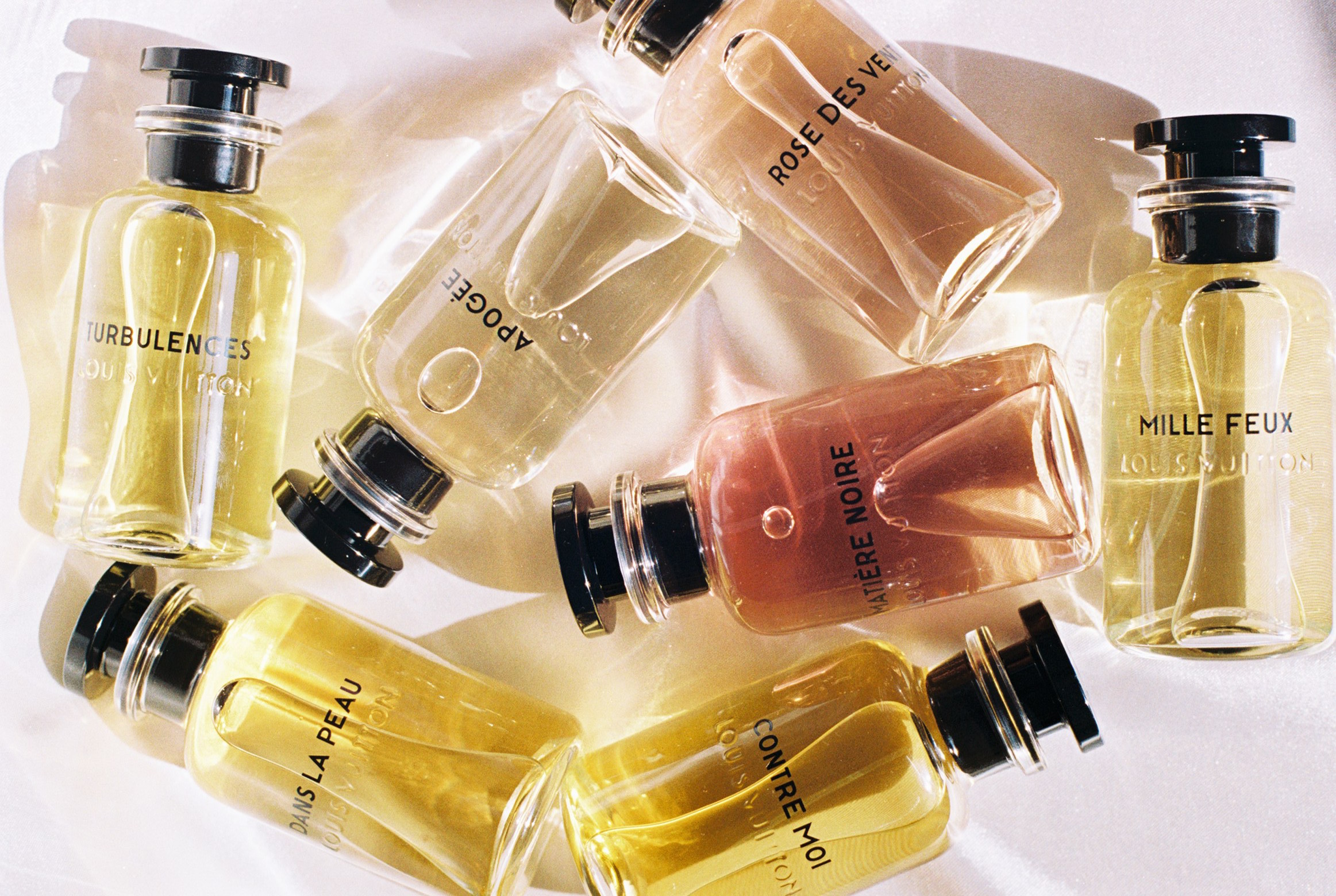
image: Louis Vuitton
Two years, thirteen scents. It is a statistic that Louis Vuitton will have under its belt next month. After expanding beyond its initial 7 fragrances to include a new scent for women, the Paris-based brand is adding five new men’s scents “at a time when Louis Vuitton’s ‘men’s universe’ is a big focus at the brand (Off-White designer and Kanye West collaborator Virgil Abloh will unveil his first men’s designs for the label in June),” per SCMP.
Aiming to tap into a burgeoning global beauty/fragrance market, Louis Vuitton announced in 2016 that it would return to the business of meeting the desires of fragrance buyers. So, the world’s most valuable luxury brand released a perfume range, following a 70-year absence from the space. Adding fragrances to its lineup of offerings is meant to enable Louis Vuitton to reach a wider range of consumers amid a downturn in luxury spending.
While it may have been unclear initially just how keen consumers would be to shell out $240 dollars for a 100ml bottle or $350 for 200ml, Michael Burke, Louis Vuitton’s chairman and chief executive officer, told WWD in January that sales of the fragrances are “exceeding expectations” across the globe.
Burke would not discuss sales figures (WWD stated that industry sources estimated “Les Parfums generated about 60 million euros in first-year retail revenues). However, he did speak to the fact that the fragrances are Louis Vuitton’s “entry price point in our stores,” meaning that in many cases, they serve as “recruitment- and image-builders.”
These are the types of products that tend to draw in younger consumers with less discretionary income (at the moment) that will ideally be converted into full-blown spenders down the line as their net worth grows. These goods also serve as a way to target consumers that cannot spend on a pricey bag or garment but want a piece of Louis Vuitton, nonetheless. With these consumers in mind, the fragrance efforts by Louis Vuitton are “an important step for the French brand as it tries to strike the delicate balance between increasing its number of more affordable goods while retaining its cachet,” per Reuters.
The publication noted, “Until now, shoppers on more modest incomes have only been catered for by Louis Vuitton’s key chains and very small leather goods, costing around €200-300 a piece. But the brand needs to boost sales growth after a sharp slowdown in the past three years, and with little sign of an industry recovery as security fears and geo-political uncertainty hit the tourism flows vital for luxury brands.”
Still yet, unlike ready-to-wear, accessories, such as handbags, tend to sell at full price (as opposed to at a mark down) at a much higher rate than garments, thereby providing brands with significant revenue streams. The same goes for the fragrance and beauty market, which in general has been more resilient in light of faltering sales of high fashion goods, and a larger downturn in the luxury market, a concept that was reflected in the “lipstick index,” a term coined during the 2001 recession by Leonard Lauder.
The former Estee Lauder chairmen created the term in response to the share rise in lipstick sales, which, he said, “indicated that women facing an uncertain environment turn to beauty products as an affordable indulgence while they cut back on more-expensive items,” such as Gucci handbags or Chanel garments.
The Making of a Beauty Giant
LVMH Moët Hennessy Louis Vuitton, which also owns Christian Dior, Givenchy, Celine, and Loewe, among other brands, is seeing the benefits of the growth of the cosmetics market in more ways than one. Aside from Louis Vuitton’s fragrance venture, Sephora, its multi-brand cosmetics and fragrance chain, has consistently posted blockbuster sales results, while many companies have taken to cutting their revenue forecasts.
The Paris-based conglomerate noted in its 2017 full year fiscal report in January – which highlighted recorded revenue of €42.6 billion for the year, an increase of 13 percent over 2016 – that its Perfumes and Cosmetics division achieved “successful innovations and rapid growth in Asia,” in particular during 2017, with total recorded organic revenue growth of 14 percent.”
Parfums Christian Dior “grew market share in all regions,” LVMH reported, while Dior’s makeup segment “grew strongly.” Parfums Givenchy had a very good year, thanks in particular to its makeup, just as Benefit which reinforced its Brow Collection.
As for the group’s latest foray into beauty, Fenty Beauty by Rihanna “is enjoying exceptional success,” according to the year-end report.
On the heels of a Puma collaboration and partnerships with Manolo Blahnik, River Island, Dior, and Chopard, Rihanna teamed up with LVMH’s Kendo division to create her Fenty Beauty line. As of early this year, the collection, which made its debut in September 2017 (on the runway at her seasonal Puma show) and exclusively in LVMH-owned Sephora stores, is proving to be a smashing success amongst consumers.
As WWD reported in January, Fenty Beauty “is on track to beat out blockbuster revenues of Kylie Jenner’s Kylie Beauty [which as of August 2017 had sold a total of $420 million products] and Kim Kardashian’s KKW.”
The success of Fenty Beauty and Louis Vuitton’s fragrances thus far – paired with the marked profitability of Sephora (and coupled, of course, with the ease with which LVMH can facilitate the exclusive sale of such goods, since Sephora falls under its ownership umbrella) – very well may push LVMH to explore this market segment with greater vigor in the near future.
Not only would it be a way to meet the beauty needs of its existing luxury consumers (and pad its bottom line as a result). It is also enable LVMH to court the highly-coveted millennial and Gen-Z shoppers who might not be ready to shell out $3,000+ for a handbag but who want in, nonetheless, on the allure that is LVMH and its brands.











